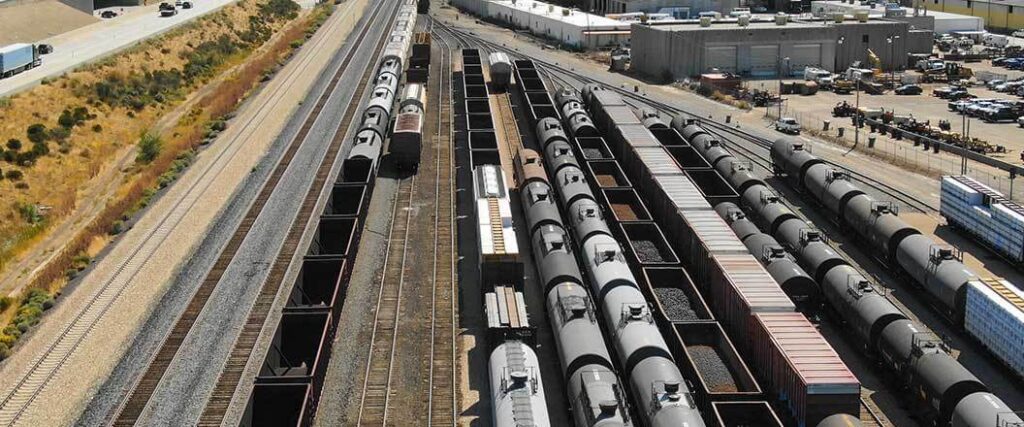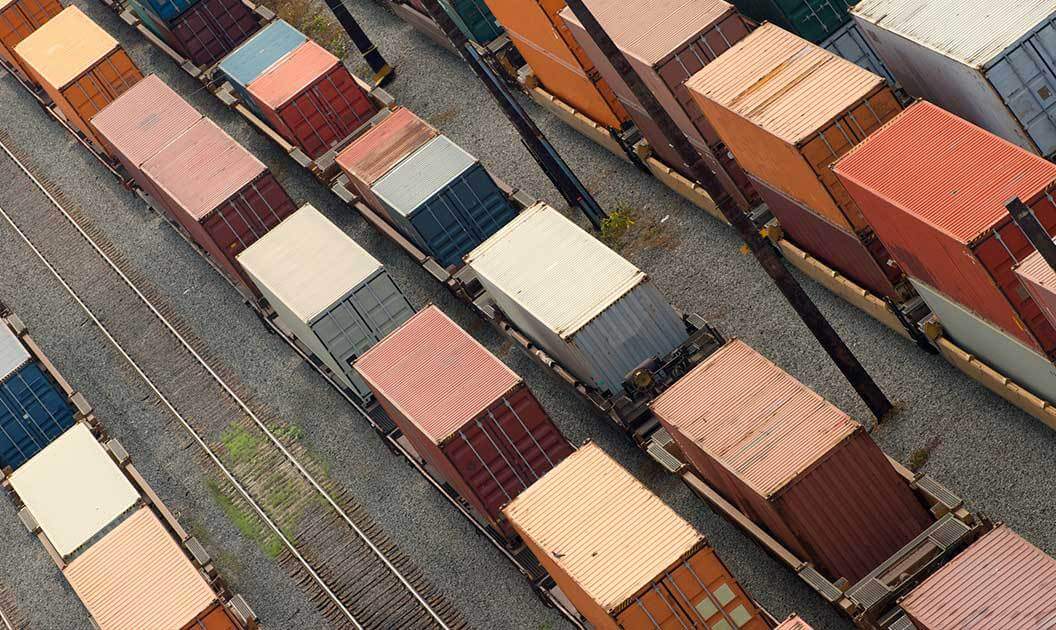Using rail transload services to get freight moved across the country is growing in popularity once again. There is a network of railroads crossing the length of North America. Goods can travel hundreds of miles almost non-stop, getting discharged near major commerce centers. Combining rail transload with truck transport opens up a world of possibilities.
Rail transload facilities exist to provide a safe and efficient way to ship various types of cargo. Using rail transport in combination with ships or trucks allows shippers to more easily ship goods like bulk liquid, oversized machinery, or agricultural products that often require special transloading processes.
Gain an understanding of how rail transload works to help your business weigh the costs and benefits of using transloading services.

What is Rail Transload?
Overland shipping covers trucking and rail freight services. Rail transload is the service that provides a bridge between truck and railway shipping.
Most often, it is used to refer to railway transloading sites. These are locations that move freight from dry van trailers, flatbeds, and more into the appropriate type of rail car.
There are many reasons why a company might choose to transload their goods to a rail service rather than have them continue in a truck. Companies that operate in places that aren’t attractive to truck drivers may find that nearby rail yards offer options they may not get elsewhere.
This is especially true if you are in an inland location. If you are in South Dakota and need to ship bulk amounts of limestone, you may struggle to regularly contract trucks willing to come to you.
Before choosing a rail transload site, make sure it’s capable of handling the type and volume of goods you want transloaded.

Are There Different Types of Rail Transload Facilities?
For the various types of commodities moved across America, there is a transload facility capable of handling them. When it comes to rail transload facilities, this is still true.
There are different types of rail transloading facilities to handle unique storage units, commodities, and destination needs.
Specialty rail transload equipment includes:
- Conveyor belt systems: These are used both for bulk solids like gravel and sand, as well as food items such as dry cereal grains.
- Pneumatic pumps: Depending on the pump, these can handle liquid materials as well as small solids like pellets.
- Overhead cranes: Often used to load bulk cargo, cranes are useful for commodities that need to travel in flat or open-top rail cars.
- Forklifts: A traditional piece of warehouse equipment, just about every transload site has some form of this machine.
- Steam boilers: Certain liquid commodities need to be heated for transfers. Steam or hot water systems are also used to clean and sterilize tanks.
- Spill containment: There are federal guidelines requiring rail transload facilities that move liquids to have a standard equipment minimum available.
- Bonded and grounded tracks: Rail transload facilities that work with potentially explosive materials must have a section of rail insulated from the rest of the track to prevent static discharge.
- Certified scales: Another common requirement, scales make sure that trucks receiving their final mile loads are properly weighed.
Specialized equipment also requires specialized transload operators. As the rail industry continues to experience new growth, it’s important to carefully vet any transload facilities before signing any agreements.
Refrigerated Transload
Somewhat separate from other transloading facilities, rail transload of refrigerated commodities is even more specialized. Shipping costs across the industry are continuing to rise, and refrigerated shipping is no exception.
Rail transload facilities moving refrigerated cargo must have access to cold storage facilities, indoor loading capabilities, and refrigerated boxcars. Locations that meet food grade requirements need extra precautions in place.
This adds to the cost of moving refrigerated commodities by rail. As more companies look to rail shipping to secure supply lines, rail transload facilities are hard-pressed to keep up.
Maintenance and refueling of gensets that run cooling systems become more difficult during long hauls. A train conductor won’t stop as often as a truck driver would. This means investing in good quality monitoring and refrigerated equipment capable of running for longer periods of time.
These details make refrigerated boxcars cost more than marine shipping containers or even trailer reefers.
Refrigerated Container Comparison
| Shipping Type | Size | Purchase Cost (New) |
| Marine Container | 40 ft | $10,000 - $12,000 |
| Truck Reefer Trailer | 53 ft | $99,000 - $150,000 |
| Rail Boxcar | 64 ft | $300,000 |
While neither the marine container nor the reefer trailer can hold as much cargo as the boxcar can, the initial sale price for the equipment is lower. There is also a wider range of quality used equipment available for carriers that might be expanding.
On the downside, in 2020, refrigerated transport only made up 5% of all freight moved by rail. To make the equipment investment worthwhile, refrigerated transload sites must work with railway lines capable of purchasing and maintaining it. Some of the biggest rail companies serving North America include Union Pacific Railroad and Norfolk Southern Railways.
Growing the refrigerated rail industry has required time, money, and the use of smart marketing strategies to attract new business.
On the upside, a refrigerated boxcar can hold significantly more than a marine container and more than a reefer trailer. Transload facilities may be able to move the loads from two containers or trailers into just one boxcar. If that isn’t an option, intermodal rail services, where marine containers can be transferred directly to a rail chassis, are available.

What Products Are Best For Rail Transloading?
There are few limits to products that can be moved by rail. When it comes to bulk transload, there are specific advantages for certain commodities when moving by rail versus truck, especially in a long-haul situation.
- Minerals and aggregate: Coal, iron ore, and other mined raw materials are both valuable and very heavy. Commonly moved on sites by dump trucks, they are better suited to being transported in open rail cars which will save significantly on gas.
- Cereal grains: When farmers need to get their wheat, oat, and corn products to processing facilities, a short road trip to a transload site offers a better deal and increases the amount that can be sent out at once.
- Liquid Chemicals: Rail tankers can hold more than trailer tankers. Transload facilities that handle chemicals may also be able to assist if any blending is needed, so you can deliver a more complete product to your clients.
- Oversized commodities: From giant wind turbines to monster construction vehicles, platform railcars provide a secure method of transport. On rail, these commodities pose less of a risk to drivers as well as anyone else sharing the road.
In the end, there really isn’t much that a rail can’t transport. For traditional palletized freight, standard boxcars operate in the same way as dry van trailers.
As rail freight services continue their steady uptick, more transload facilities are expanding and restructuring their yards to operate as combination rail/transload/warehouse centers. These locations would then be able to provide more than just transload - they could provide access to direct final mile fulfillment services in the area.
Truck transport services cannot be entirely replaced by rail - flexibility in that final mile is crucial. However, premier transload facilities are proving that flexibility in the mode of transport is also crucial to developing efficient and successful supply chains. You can’t truly rely on only one method.
Many shippers combine transload services with local drayage for the first or final mile between the rail facility and port.

Let Transload Services USA Get Your Freight on the Rails
From coal to cotton and everything in between, rail transload facilities are equipped to provide your business with options. Don't get stuck asking what is rail transload from the amateurs when experts are standing by. Trust the logistics experts at Transload Services USA to connect you with facilities that can meet and exceed your expectations.
We work with industry experts who can advise you on the best way to move your freight. Get the most out of the services we offer and take advantage of our excellent:
- Transloading services
- Cross docking services
- Freight Rework services
- Freight Consolidation services
You can get an online quote today and be on the way to a better shipping experience. If you would rather speak with a representative directly, please contact us at (352) 282-4588.

